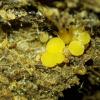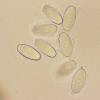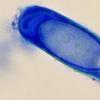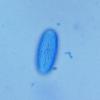
21-12-2025 09:32
Hello.A tiny ascomycete found embedded in wood in

21-12-2025 21:32
Pol DebaenstHello, Garden, Burgweg 19, Veurne, BelgiumOn 10/1

22-12-2025 23:38
Patrice TANCHAUDBonsoir, récolte sur un mur en pierre, apothéci

22-12-2025 00:47
Patrice TANCHAUDBonsoir, récolte à proximité du milieu dunaire

21-12-2025 21:40
Isabelle CharissouBonjour, j'aimerais connaitre les références de

20-12-2025 23:08
Patrice TANCHAUDBonsoir, récolte sur sol sablonneux dans l'arri�
 Hello, I hope someone can help :). On dung of (wild) cow were these clustered asco's, bright yellow. Mature up to 1-1,5 mm, it takes them a lot of time to release spores.
Hello, I hope someone can help :). On dung of (wild) cow were these clustered asco's, bright yellow. Mature up to 1-1,5 mm, it takes them a lot of time to release spores.Asci narrowly cylindric and long: 200-218 x 11-15. Croziers +, IKI -. Paraphyses about the same length, enlarged apex up to 6µ. Rather hyaline to my suprise, just a little pale yellowish.
Excipulum textura angularis-globulosa.
Spores quite large, av 20,9 x 10, Q=2,08. Narrowly ellipsoid, smooth, hyaline and cyanophilous. Normally I see de Bary bubbles clearly but this time not quite so. I think they have them, but am not sure? Eliminating a lot, the only thing that comes close as far as I can see is Coprotus ochraceus. But some features differ (a bit) from literature: size of spores, paraphyses and length of asci.
What do you think? Again: thanks in advance!
Greetings, Maria

I am not sure that your mushroom is a Coprotus, moreover it does not seem ripe enough. Maybe you could wait a little longer so that you can also make a preparation in the Cotton Blue with ejected spores.
Michel.

First: thanks for your help! I am an absolute amateur in mycology, but I have seen de Bary bubbles: they are visible even in the asci. I include a photo of a released spore in CB: no de Bary bubble to be seen. So it must be a clear visible nucleus that I see, but not a de Bary bubble.
I am really absolutely at a loss with this one: it's not Cheilymenia, not Byssonectria, not Lasiobolus, I don't think its Thecotheus .... This is a bright yellow asco, quite large, taking forever to 'ripe'. The photo of the spores I included earlier was from one ripe ascocarp.
Do you have an idea of what it could be?
Greetings, Maria

Your last photo of spores in the blue seems to show a yellowish reaction inside that could point to Cheilymenia.

I will do that and thanks for all your help!
Greetings, Maria

I waited as you adviced me and with that, I was able to get mature spores in CB.
As you see, the spores have delicate and fine reticulation.
So thank you for your pointer towards Cheilymenia!
Seeing the fact that there are no hairs my question now is: is it C. granulata with strangely pale paraphyses and larger spores or could it be C. crassistriata? I saw the post of Lieve Deceuninck (2020) and she also speakes of yellow (instead of orange/orangish) apothecia and paraphyses with a pale apex. Also, I get the impression that the spores of C. granulata are somewhat smaller than those of C. crassistriata. On the other hand it seems that the reticulation on the spores of C. crassistriatis is less fine and delicate than on spores of C. granulata.
With this, is it possible to come to a determination? If not, I will accept my defeat :) :).

Your photos confirm what I thought. The ornamentation of the spores of C.Crassistriata does not seem to me to be suitable, but it is true that I know this species very little. What also distances it from C.crassistriata is the width of the paraphyses, very thin on this species. On the other hand, you do not speak of hairs either; on this species there are normally lateral hyphoid hairs.
Several varieties of C.granulata have been described in particular by J.Moravec; perhaps you could look in that direction, but without conviction on my part.
Does anyone have another idea?
Michel.


Have a good Sunday.

Better luck next time :)
Greetings, Maria







